Dec 25, 2025
Dec 25, 2025
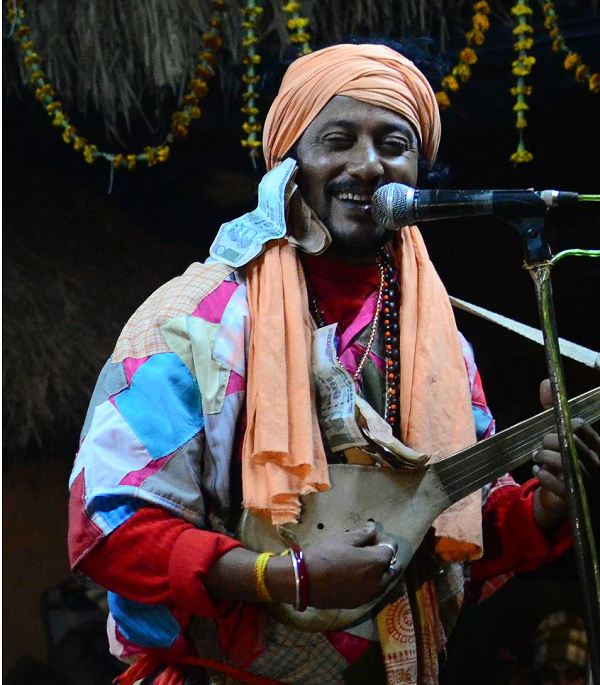
Jaydev Kenduli (23.63°N 87.43°E) is a village on the banks of Ajay River, and a gram panchayat in Ilambazar block in Bolpur subdivision of Birbhum District in the Indian state of West Bengal. The place is associated with poet Jayadev (popularly believed to have been the court poet of Raja Lakshman Sen, who ruled in the 12th–13th century), composer of Gitagovinda in Sanskrit, and is believed by many to be his birthplace. There is academic controversy over the matter adoringly called “Jaydev birth controversy”, and many scholars believe that Kavi Jaydeva was actually born in Orissa at a place called Kenduli Sasan. Like all academic disputes, the matter is controversial only in the ivory tower of academia and finding its natural channel in regional politics (both Bengal and Orissa claiming Kavi Jaydev in the name of racial sentiment), overlooking the fact, nay, rather ignorant of the fact that a poet cannot be confined to the identity of any particular nationality or race or region, and that a Belief, even if Myth, that has prevailed for centuries giving birth to a distinct Culture is Reality itself.
Needless to say, the so-called controversy has no effect on Folk Culture – the Jaydev Kenduli Baul Mela – that has been continuing undisturbed and unperturbed at Jaydev Kenduli village for over five-six centuries in the name of Kavi Jaydeva.
The Jaydev Kenduli Baul Mela is an annual fair organized on the occasion of Makar Sankranti that mostly falls on 14th January every year (on 15th January in leap year). The Mela continues for 3 days (It starts on the last day of the Bengali calendar month Poush and continues up to 2nd Magh). This year (2013) the Mela was from 14th January to 16th January.
The programme of the Mela is as follows:
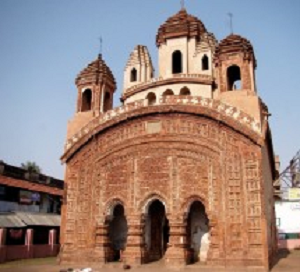 In the history of Bengal, Jaydev Kenduli was part of Senpahari pargana during the Mughal era. Aurangzeb issued a firman in the 17th century and added Senpahari to the property of Krishnaram Rai of Bardhaman Raj. It is believed that the Maharani (queen) of Bardhaman established the Radhavinod temple at Jaydev Kenduli in 1683 at the request of then court-poet at Bardhaman - Jugal Kishore Mukhopadhyay, a resident of Jaydev Kenduli.
In the history of Bengal, Jaydev Kenduli was part of Senpahari pargana during the Mughal era. Aurangzeb issued a firman in the 17th century and added Senpahari to the property of Krishnaram Rai of Bardhaman Raj. It is believed that the Maharani (queen) of Bardhaman established the Radhavinod temple at Jaydev Kenduli in 1683 at the request of then court-poet at Bardhaman - Jugal Kishore Mukhopadhyay, a resident of Jaydev Kenduli.
There is an interesting legend regarding Kavi Jaydev and his masterpiece Gitagovinda, and how they relate to the origin of the Mela.
While composing Gitagovinda – that celebrates Radha as the Primal Shakti and greater than Krishna, Kavi Jaydev got stuck at a particular ‘pada’ in which he wanted to make Krishna hold Radha's feet (a gesture of Shraddha for elders and seniors in “Hindu Tradition”, and Kavi Jaydeva actually wanted to show that even God or Avatara is Daasa or slave of His devotee), but perhaps being hesitant, he could not do that, because how would Krishna the Lord of the World hold the feet of his secret lover?
Kavi Jaydev, in his hesitancy, underwent – what we may call “Poet’s Block” – and could not render the scene poetically. For the time being, he decided to leave the composition at that phase and thoughtfully left to have bath at Ajaya River. No sooner had he left that his wife Padmavati saw him coming back. Surprised, Padmavati asked him the reason. Jaydeva said that the ‘pada’ had flashed in his mind and he had hastily returned to write it down immediately lest he forgot. Then he wrote down the lines and went to bath again after taking food. Padmavati, having fed her husband now sat down to take his ‘Prasada’ on the same plate (called ‘Swami-seva' – certainly not very palatable for modern feminists). As soon as she had started eating, Jaydeva returned and seeing her eating before him (the wife was not supposed to eat before her husband), he was a bit offended and asked her why she had done that. Now it was the turn for both to be surprised, because when Padmavati said that he had returned sometime before, composed the lines, and then left after eating, Jaydeva vehemently denied having returned earlier. Instantly Jaydeva could guess what might have happened. He rushed to see his composition and saw the following lines written –
“Smaragarala khandanam mama shirasi mandanam
Dehi padapallava mudaram”
(“Please place your foot on my head, as a sublime blossom
that can destroy the poison of the sufferings of love”)
The wonder-struck husband and wife could only share their wonder and joy on realizing that none other than Krishna came in Jaydeva’s guise to compose the lines that the poet had hesitated to write. “It is said that while Krishna was writing, He playfully joked with Padmavati, saying that the oil massaged into His scalp was trickling down into His eyes, so that He could not see well. Padmavati lovingly wiped the oil off from the brow of her husband, by using the front part of her sari. Then she left Him to His writing and went to take her own meal.” (“Puri: The Home of Lord Jagannatha” by Parama Karuna Devi and Rahul Acharya)
The Jaydeva Kenduli Baul Mela is organized in memory of that auspicious day of Jayadev’s bath at Kadaambokhandi ghat on the occasion of Poush Sankranti or Makar Sankranti and the start of the fair commemorates the day on which Jayadev is claimed to have taken the bath at the Ajay River, and Padmavati saw Krishna in physical form.
The Mela at present centers on the Radhavinod temple established by Maharani (queen) of Bardhaman in 1683 – and this temple is undoubtedly the “pranakendra” (life-centre) of the fair.
Radhavinod temple – that has exquisite terracotta carvings (http://www.indianetzone.com/9/terracota_sculpture_west_bengal.htm) depicting Ramayana and other Puranik scenes.
From history and legend, now I come back to my personal experience with Jaydev Kenduli Baul Mela.
I visited the Mela for the first time in 2003. It marked the beginning of my interest in Folk Culture particularly Baul songs – an interest that has sustained and enhanced till date. If that is one reason to visit the Mela again, that is not all.
Observing people’s activities in a Mela is a reward in itself. There is so much to learn on human manners and nature. One only needs to observe silently, without interfering, like the mature Self observes as a witness the turbulent Mind. More than that, a Folk Mela of this stature that vibrates with Life and people’s Living Belief collapses all ivory-tower academic controversies – and I enjoy that more than anything else.
This year when my school pal Arjuna proposed a visit (his first visit), I agreed at once because I needed to ‘recharge’ myself with Baul songs.
The ‘we’ visiting the Mela this time were six. Shaibal-da, a professional photographer and photo journalist, Joydip Bhattacharya alias Buro-da, a friendly wise senior with ‘Bhabaghure’ and adorable “Addabaj” mentality, Arnab, my friend-cum-brother (“Paratuto Bhai”) and partner in my recent trips, and Arjun, my occasional trekking partner and school pal. Other than the ‘I’ in this team, we had a guest – an American Jewish, Margot Cohen, working in Bangalore for the last seven years. What made the energetic and pretty woman prettier in my eyes is her love for Indian Culture particularly Folk Culture. I was also glad to learn about her interest in Wayang puppetry of Indonesia – almost a common interest I share. She had been to this Mela three years back, and the inescapable attraction of the Baul has drawn her back again.
Our team
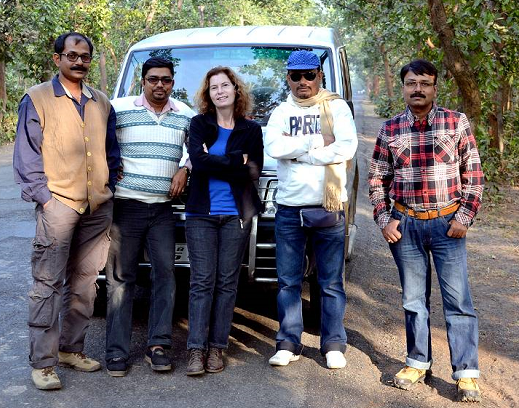
On the day of the journey I learnt from Arjuna that we would have a surprise guest. He was Kavi Arun Chakravorty.
I was glad to know that Kavi Arun Chakravorty would go with us from Chandannagore. He is a well known poet, and perhaps more famous for his composition of the folk lyric “Lal Paharir Deshe Ja, Ranga Matir Deshe Ja.” (See the recitation of the lyric in poet’s own voice and a modern version See an ‘original’ Baul singing the song; See another Baul singing in his own style). Every Bengali now knows this song. Bauls love to sing it, and “Band parties” of modern Bengali music world love to steal it.
Kavi Arun Chakravorty has been going to the Mela for the last 51 years, and has been associated with Sudhir Kshyapa’s Akhra at Tamaltala. An Akhra is a gathering of groups of people under a common roof for religious purpose, particularly practice of religion through devotional songs and music. Sudhir Kshyapa (or, Sudhir Gosai) was a renowned Baul. He died 25 years back and is survived by his wife (called ‘Sadhana-Sangini’ in Baul society), and his ‘adopted son’ (not biological – Baul’s do not become biological parents) Lakshman Das Baul.
This Akhra is one of the oldest Akhra in this village, and claimed by some to be the oldest.
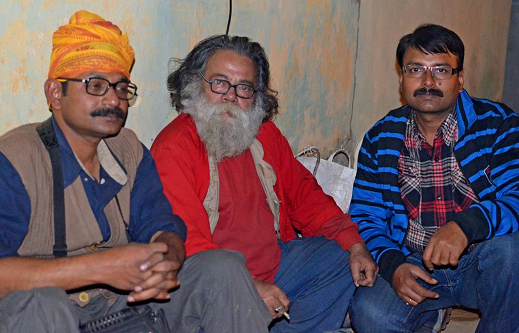
Arjuna (left), Kavi Arun Chakravarty (middle), and the author
Starting from Chandannagore at 8.30 am on 14th January 2013, we reached Bolpur at 2 pm after dropping Arun-da (Kavi Arun Chakravorty, now aged 75 years, is universal “dada”). Bolpur is 2 km from Kaviguru Rabindranath Tagore’s Shantiniketan. We had a hotel booked midway to Bolpur and Shantiniketan. After having our lunch there, we took rest for sometime and then started for Jaydeva Kenduli Mela.
We had a hard time parking our vehicle at the parking lot. After the hazard was over, we reached Sudhir Kshyapa’s Akhra after visiting the Radhavinod Temple.
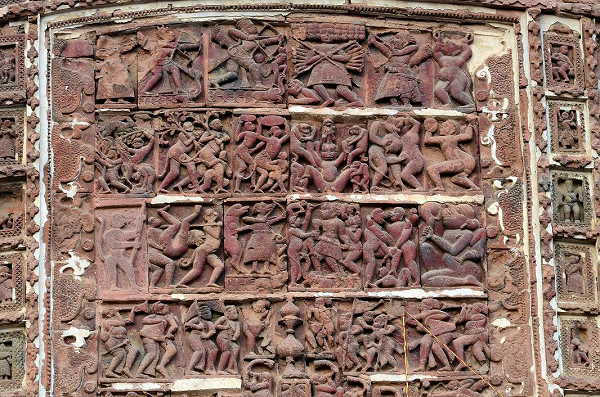
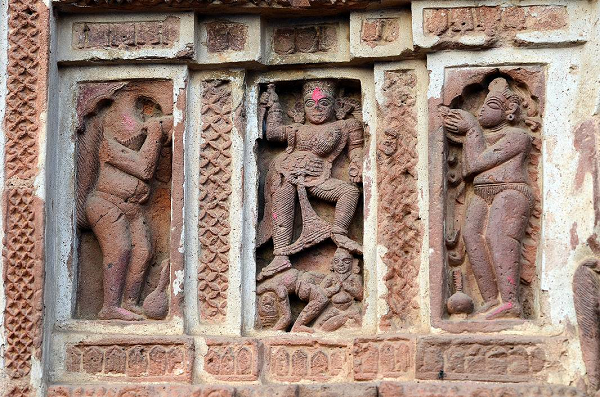
Terracotta sculptures on temple wall
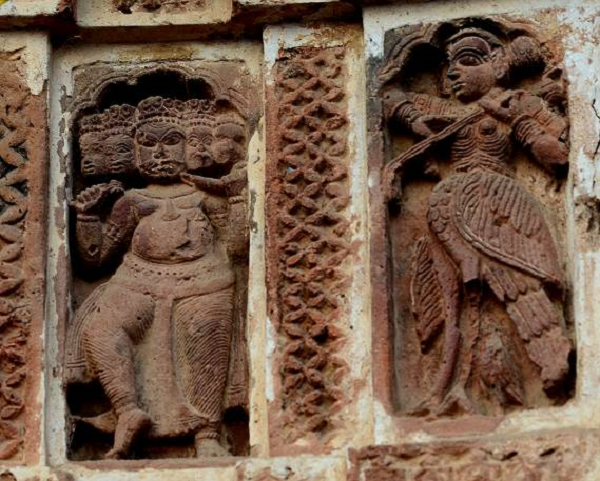
Terracotta sculptures on temple wall – Ravana on the left niche
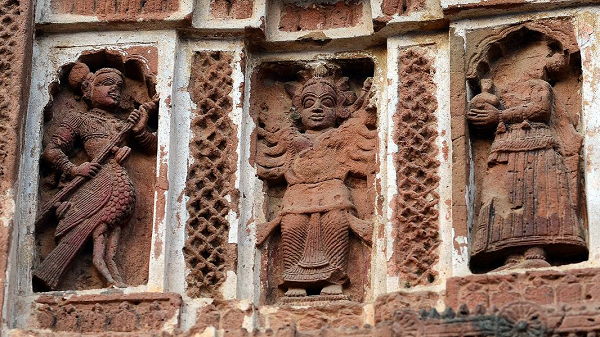
Terracotta sculptures on temple wall – Durga in the middle niche
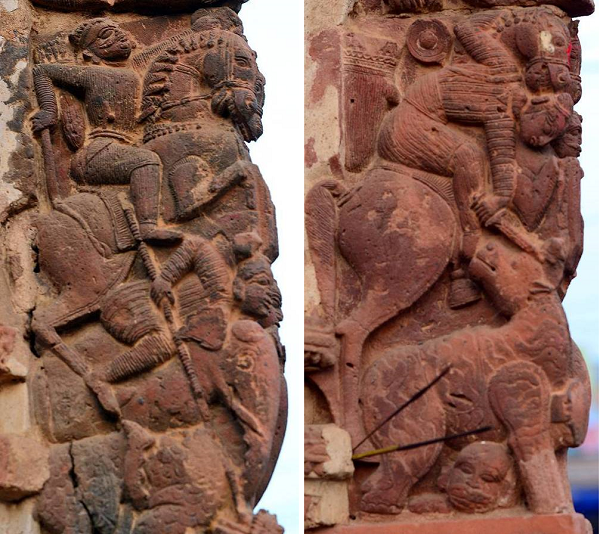
Terracotta sculptures on temple wall – war scenes
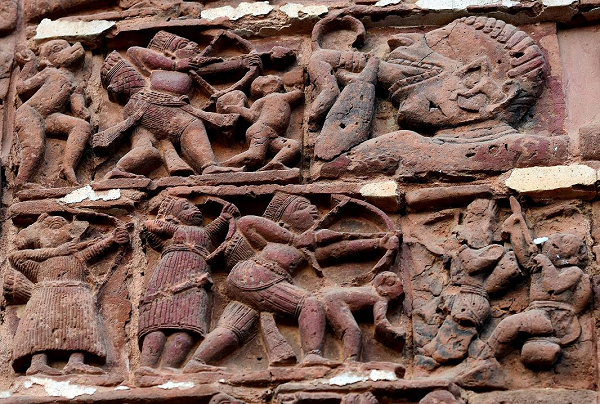
This is a depiction from Ramayana.
The upper panel depicts Kumbhakarna eating a monkey soldier,
and Rama/ Lakshman fighting with him.
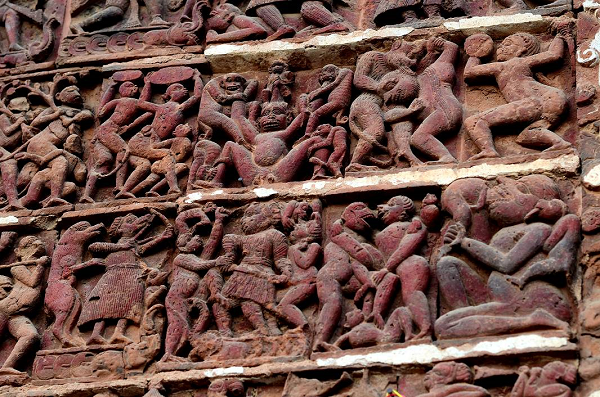
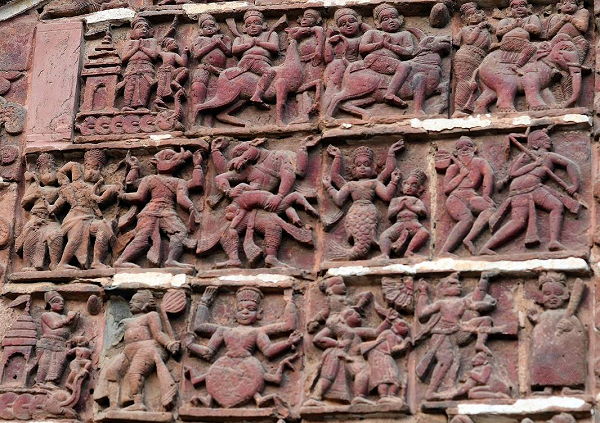
Terracotta sculptures on temple wall
While walking to Sudhir Kshyapa’s Akhra, or rather floating like twig in the wavy crowd, we observed the colourful sellers and their colourful wares shored on either side of the roads. It seemed everything could be found in the Mela.
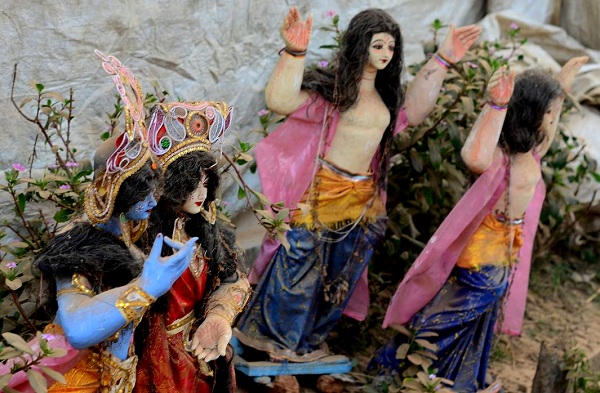
Abandoned Radha-Krshna and Gaur-Nitai idols outside an Akhra
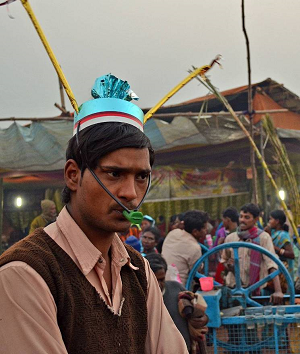
“Bhempu” (whistle) Seller
After reaching Sudhir Kshyapa’s Akhra, we met Arun-da. We decided that this would be our permanent “thek” for today and tomorrow, and that making this our ‘sun’ we would rotate around in the Mela.
It is a beauteous evening, calm and free,
The holy time is quiet as a Nun
Breathless with adoration; the broad sun
Is sinking down in its tranquility
(“It is a Beauteous Evening, Calm and Free” – Wordsworth)
As evening fell, one could hardly feel the loss of sunlight as the whole Mela was now lit up with electric light. We decided to take a stroll in the Mela. It was so full of light and colours everywhere. People walked on in never ending stream. We could hardly feel the cold in the crowd, and could only realize the falling temperature once we stood in open space.
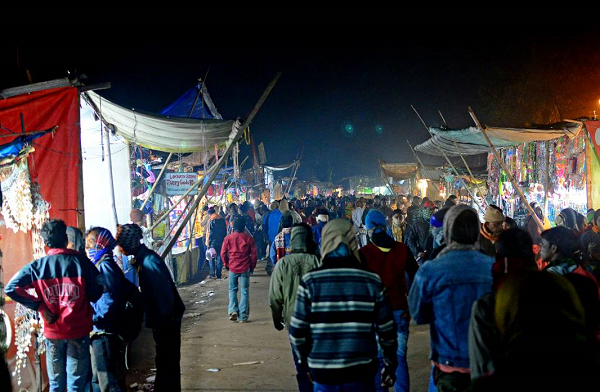
Mela at evening- the crowd thickens
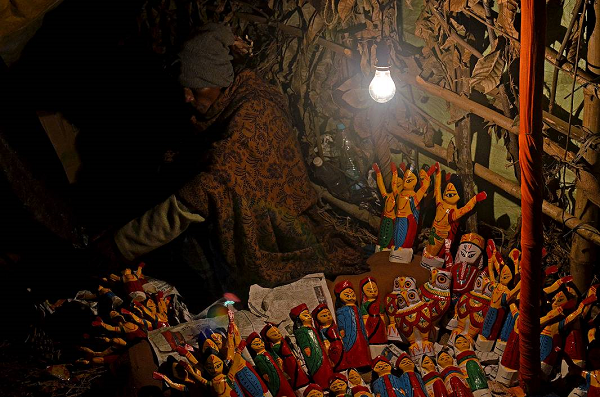
“Doll’s House” – a seller selling wooden dolls of Gods and Mahapurush (great men)
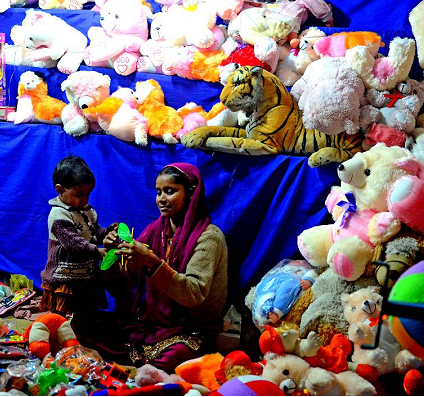
Doll seller and the ‘little doll’
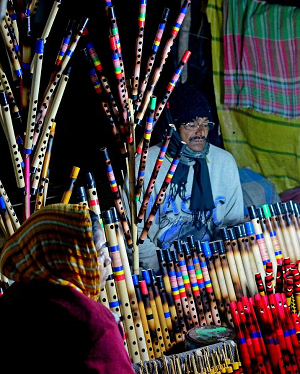
Flute Seller
Not only peddlers, but also “circus-walas” had their share of offering fun in the Mela.
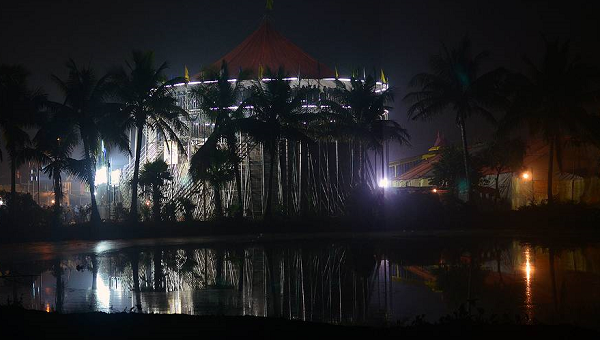
“Maut ka Kua” (Well of Death)
Despite the risky game going on inside, from a distance the reflection looks very beautiful – perhaps, a metaphor for life as it is, or the Social Reality of most village people who throng the Mela. And then there was the ever green Merry-go-round.
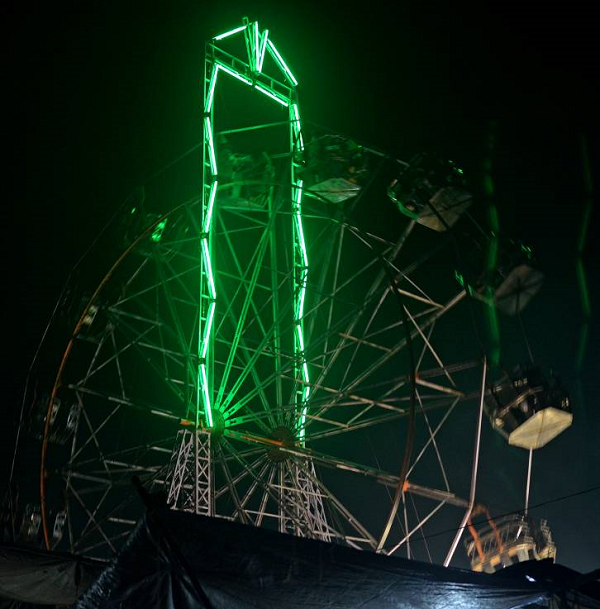
Merry-go-Round
And there were of course – true to the spirit and legacy of pilgrimages – the beggars. The beggars mostly had their place on either side of the path that goes across Ajay River. Ajay is no more ‘ajay’ – unconquerable!
Physically challenged beggars lay at the middle of the path with lamp on their body or beside them – some of them making queer sound to draw attention of passers by. Some sat quietly by the side with widespread cloth before them. And there were also the Sadhu-Beggars – dressed as Sadhu sitting in front of their makeshift tents.
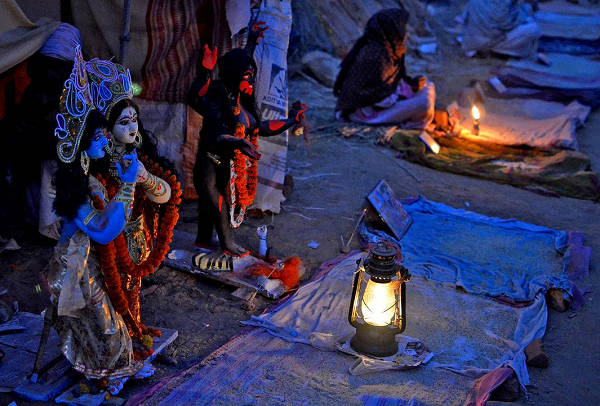
Radha-Krishna and goddess Kaalii idols in display in front of a Sadhu-Beggar tent.
Other beggars without tent sit under open sky lining the Path.
After roaming about the Mela for an hour or more, now it was time for us to concentrate on the main attraction – Baul songs. Bauls and Kirtaniyas had already started their performance in the Akhras.
The most beautiful part of the Mela is undoubtedly the Baul songs that go on overnight in different Akhras. It is for this reason alone that Jaydeva Kenduli Baul Mela has become one of the important centres of Folk Culture in Bengal, nay, in the whole world – indeed, a unique blending of religion, music, songs, poetry, folk lore, and livelihood.
There are many Akhras in Jaydeva-Kenduli, and they set up ‘pandals’ with a ‘mancha' (stage) complete with lights and sound system. To my knowledge there are 78 permanent Akhras that have their fixed area along the bank of River Ajay, and that have constructed concrete structures over the years in the memory of their Guru, Diksha Guru, or originating Sadhakas.
Many Akhras from outside also set up their tents and ‘pandals.’ And then there are the ‘modern Akhras’ of ‘nagar Bauls’ (urban Bauls – I call them “Jhinchak Bauls”) with latest musical instruments and sound systems. According to one estimate, every year, more than 200 Akhras participate in the Mela.
Jaydeva Kenduli Baul Mela is now indeed a ‘globalization’ of Folk Culture and Urban Culture of different hues. The ‘hybridization’ is a big frustration for those who like to hear Baul songs in its ‘original’ and pristine form.
Too many urban-Bauls frequent the Mela nowadays, and sing (rather, try to sing) with modern music systems. Some Bauls too use modern music system. The result is disastrous. If readers feel that I am taking here an Orthodox stand, I would be glad.
And then there is the right concern that the Mela is gradually losing the Baul-flavour because nowadays Vaishnavite Kirtaniyas overwhelm the number of Bauls. According to one estimate, only 10 Akhras extant now are ‘pure Baul’ Akhras, while some are ‘mixed’ in that both Baul songs and Kirtans are sung alternatively (or, evening to midnight reserved for Kirtan singing, and the rest of the night till morning for Bauls). However, the majority of Akhras are now dominated by Kirtaniyas.
The most glaring ‘negative’ of the Mela is the prominent and evident degeneration of the Spiritual tone and ‘seriousness.’
Many Sadhus throng the Mela – many of them are Sadhus in dress only. All their holiness is in “Ganja” and “Charas.”
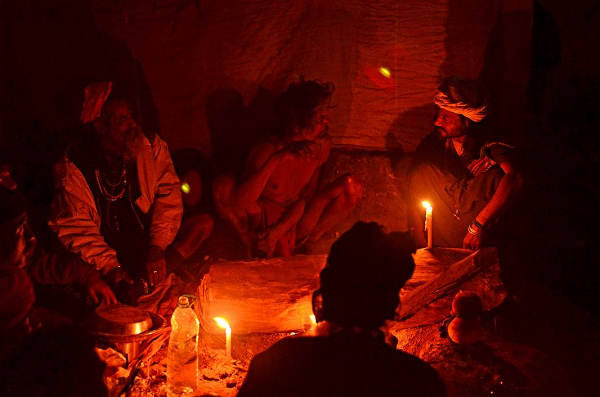
A typical “Ganja and Charas Thek” (Hemp circle)
Much has been written and researched on Bauls (also available on the Net), and I hope readers have some idea on them. So, instead of attempting here a detailed introduction on Baul, Baul philosophy, and Baul tradition of Sadhanas, I will give here a brief outline on the same.
Bengal’s Bauls form a distinct community, and are a common sight in the Bolpur district of Bhirbum, in Bankura, Murshidabad and Nadia. Living a life of self-imposed poverty is part of their Sadhana through the yoga of song.
Etymologically, Baul originates from the Sanskrit vatul connoting “divine madness.” The colloquial Bengali word batul also means “mad.” However, here ‘mad’ has a different significance. ‘Mad’ is a social label for those whom the society considers misfit. The very adoption of negatively labeled social words like “Pagol” and “Kshyapa” (meaning ‘mad,’ ‘crazy’) to identify the highest and most spiritually progressed Bauls is an indicator that Baul philosophy is basically a revolt against stereotyped and static Social Norms. It is an unconventional philosophy that believes in the Religion (Dharma) of the Heart and not Brain – an understandable reason why the Baul has to oppose society if not being in conflict. Perhaps, forming a separate community is immunity from direct confrontation with society – and the opposition and conflict is not tangible enough for society to think of a ‘political’ solution to the “Baul problem.”
The essence of Baul philosophy is Bhakti, and is in fact a synthesis of elements of Siddha, Tantra, Vaishnavism, Buddhism and Sufism. Thus, Baul is Beyond all conventional Religion, and Synthesis too. The primary object of Baul is to reach the “Moner Manush” (“The Man of the Heart/Mind”) – it is a search that might start by loving the “Other” but that ends in the Self with the realization that the Self and Other are not different. Such a realization requires complete annihilation of all emotional, mental, physical and physiological bonds and blocks.
The Baul philosophy is very much Upanishadik in essence – particularly in giving primacy to Heart like in Upanishad, and in preaching the object and essence of Life to be Ananda, not Happiness. (Ananda implies Joy without Psychological Dependence, whereas Sukha or Happiness has Psychological Dependence in its core)
Once the Bauls were considered auspicious and indispensable spiritual asset to the rural farming society, and thus they were supported by alms. But India’s changing socio-economic reality has caused a sort of devaluation of this spiritual asset. The growing materialistic inclination in Culture in general even in rural society has relegated the Bauls to a corner. Market economics and industrialization have brought the Tollywood and Bollywood Culture to rural society, mesmerizing the youths with show of ‘skin’ glamour and shallow and hollow music.
As a result, major section of Bauls have also transformed to a great extent to keep pace with changing times and to find new ways to survive. Many Bauls (that actually imply Sadhaka) have transformed to Baul singers who perform like any other performing artists. Since begging is no more a respectable profession (it never was, with the exception of Baul-Sadhaka's and Sannyasis), and a Materialistic Culture has constructed mass consciousness (generally speaking) to doubt Spirituality, many Bauls now sing and perform to earn livelihood.
And what a change in the theme of lyrics of these Baul singers! Many new songs composed by them lack in depth and ‘Bhava.’
Once the Bauls would wander around (reminding of Vraatyas of Vedic Age), never settling down, leading a nomadic life, singing about the love of their Beloved, and doing intense Sadhana – in some cases, of Baamaachara type (of Tantra). Now, the changing Social, political and economic scenario have prompted the Bauls to settle, to set up ashrams, and even to adapt to urban living conditions. The style has also undergone change. Originally, Baul performances used to be solo; however, today they have some ensembles, and they also have ‘hands.’
In Baul Sadhana there is no need of a formal training. One takes this path with the spirit of complete love and surrender without which one cannot be called a true Baul. Singing song is abandoning oneself in the complete bliss of the moment – the ‘present’ – and that surrender must be Natural and Spontaneous with merger with the song. The song is thus a vehicle to reach the Beloved – called “mon” (mind) or “moner manush” (the One of the mind). Song is thus primary in External Reality, but secondary in Internal Reality where melody and rhythm are only the Surface Layer of deeper Ananda.
A Baul Guru (Diksha Guru, or song Guru) teaches his/her disciple through practical training. The disciple (called Chela or Cheli) has to sing with him/her in all the festivals, and sometimes he/she teaches him/her right on the stage while the concert is going on. The teaching includes not only singing but also footwork of Baul dance and playing the duggi, the hip-drum.
After the learning, the disciple must go away from the Guru, and he/she might take some other Guru. The new Guru might make him/her pass through rigorous tests to be sure of his/her determination. Once the Guru becomes sure of the disciple’s spiritual inclination, he/she showers all love on him/her, and explains the depth and vastness of this tradition.
The Sadhaka is at liberty to choose the particular instruments he/she will use. Ektara (or gopi yantra), the duggi (or bama), and the chilambu (or nupur) are common instruments.
Ektara has a special place in the Baul tradition, and is the most prominent symbol of Baul. Ektara, or gopi yantra, is a traditional one-string instrument, made of dried pumpkin, gourd, wood or coconut shell, and one has to play it by plucking the string with one finger. Baul’s believe that the Ektara produces “Om” (or, “AUM”) sound.
The other common instrument is Duggi, or bama, a small bass drum made up of clay and leather, weighing around four and a half pounds, and the Baul straps it around his/her body during the performance. To keep rhythm, the Baul also uses chilambu nupur or anklet bells.
Traditionally, Bauls sing in the satsangas in the Baul ashrams or at the yearly festivals held at Baul ashrams, known as mocchab. Bauls also gather for annual Melas.
Rabindranath Tagore introduced the Baul tradition to the urban intellectual society by organizing the Poush Mela in Shantiniketan. Tagore’s own compositions were deeply influenced and inspired by the most celebrated Baul composer, Lalan Fakir of Kushtia (Bangladesh), who lived around 250 years ago.
There is a famous painting of Rabindranath Tagore, as 'Baul' by Abanindranath Tagore (n Phalguni, 1916)
Baul songs are metaphorical and allegorical, and like in English Metaphysical poetry, there are multiple layers of meaning and significance – at least 3 layers.
Let me try to explain this with an example.
There is a nice old Baul Song in Bengali –
“Khejur Gachhe Hari Bandho Mon
Naile Rasa Gariey Gora Poche Akale Hobe Maron.”
(Listen to the song here A | B | C)
Here is my English rendering of the lyric:
“O Mind, tie a pot on the date palm tree
Lest the wasted juice falls, rots the root, and the tree dies untimely.
When it is tide for the tree
Draw juice with skill
Be careful you don’t fall on the ground.
Juicy juice drawers
Climb the tree with care
And embracing the tree with two hands taste juice.”
What does the tree stand for?
At the first layer or surface layer, the tree is the literal tree, and the lyric is the utterance of a juice-drawer (poetic persona of the lyric) – a common profession in rural Bengal.
At the second layer, the tree represents woman, and the juice-drawer is none other than a skillful lover.
At the third layer, the tree represents Life, and the juice-drawer is the wise every man who knows how to extract and taste Rasas of Life.
In short, the three layers of meaning in a typical Baul song are – a) Literal, b) Sexual (or, Man-Woman Heterosexual Love Relation), and c) Philosophical / Metaphysical.
Thus, mundane, sexual, and philosophical – all are integrated and go together – and each is Metaphor and Allegory for each other in a complex network of significance.
In my opinion, Baul songs are in the tradition of RgVedic poetry in this respect.
Undoubtedly, the all-time favourite Baul song is “Golemale golemale pirit koro na” popularized by the most famous Baul singer Purna Chandra Das Baul. The song is a tribute to Kavi Jaydeva’s wife Padmavati, other than having its usual philosophic message regarding the Power of Love.
Now, leaving theory behind, I return to Jaydeva Kenduli Baul Mela again.
At Jaydeva Kenduli Baul Mela, Bauls go from Akhra to Akhra (selection is their discretion) and sing songs for three consecutive days for whole night. In this way, an Akhra is never in dearth of Baul singers. Usually a Baul is allowed to sing 2-3 songs (more, when the audience enjoys, or the Baul is renowned, or when the next Baul has not yet arrived). He is then presented with a token gift, usually Rs. 20/- (depending on the Akhra) - and the audience too often gifts him with currency notes – often going on stage and sticking the currency note on his “alkhalla” (Baul’s robe) with a pin. Sometimes, the audience tucks the currency note in the Baul’s “Pagri” (turban).
Walking on the streets in the Mela is a chaotic affair – one is forced to listen to simultaneous songs from different Akhras going on in full volume – however, when one stands at the gate of an Akhra or enters an Akhra, it is the song of the Baul in that Akhra that is the only reality then.
As the Bauls start singing from their heart, feeling in every pore of their body the Joy of rhythm, their Natural and Spontaneous Ananda enlivens the songs and music. The Akhras come alive when the audiences too feel that Joy and start dancing, clapping or swaying with the songs. It is a scene never to be seen anywhere else.
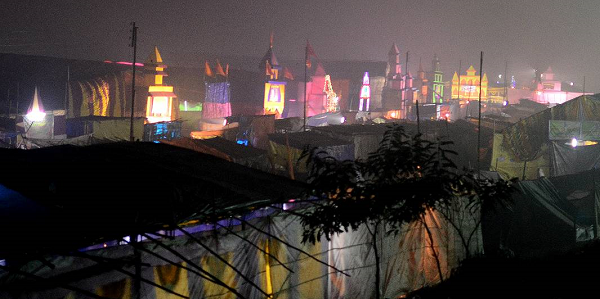
A view of Akhras at night (shot from embankment of Ajay River)
Let us note how the colourful Akhras lit up the night. I invite readers (who have not visited Jaydeva Kenduli Baul Mela, or similar fairs) to imagine how it is like, when Bauls and Kirtaniyas sing in full throated ease in each and every Akhra simultaneously.
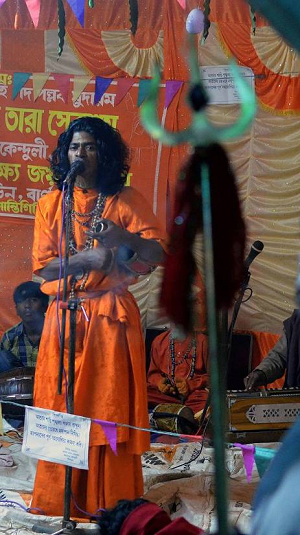
Baul sings in an Akhra – a pilgrim stands with Trident at the door
After watching for hours some wonderful Baul performances at Sudhir Kshyapa’s Akhra, I and Arnab decided to take another stroll around the Mela. It was 2 am. As we walked out of the Akhra, we could feel what winter is like in a remote village of Bengal.
We saw the ever awake tea stalls, and drank smoking hot tea.
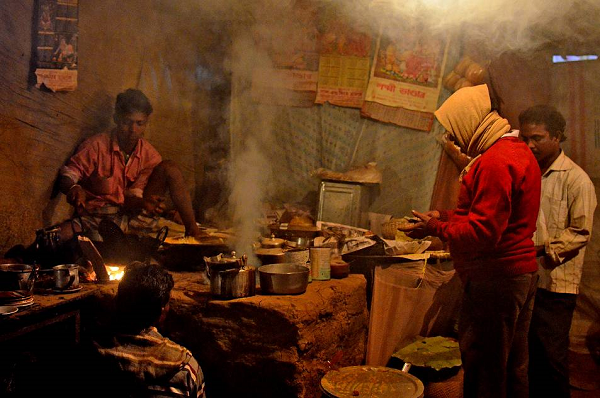
An ever awake tea stall
However, the hot inside could not be enough.
As we ascended the embankment (‘baandh’) of Ajay River, I found some people making fire. In the thick smoke, some seemed to be on fire, while some other looked like ghosts.
As the night deepened and the cold intensified, the hot inside or outside could not be enough for many. Baul songs could not be enough stimulants to keep them awake.
Now it was sleep time, and tiredness and exhaustion got the best of many.
I saw a man who was sharing the outside “uthan” (small lawn) of an Akhra with the idols of Shiva and Parvati. As he warmed his foot in fire, the scene caught my attention because Shiva seemed to be looking at him and smiling.
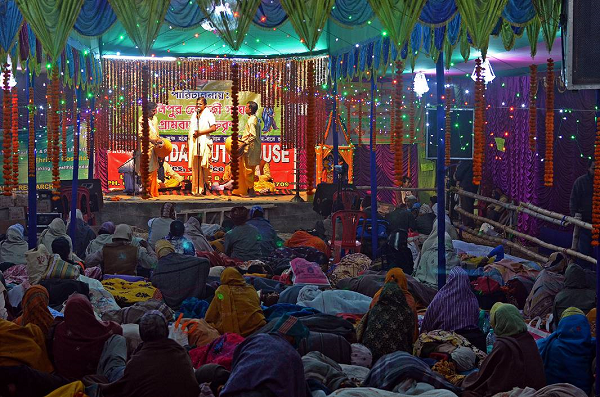
Lone Kirtaniya – the Kirtaniya sings in this Akhra, but most of his audiences are fast asleep.
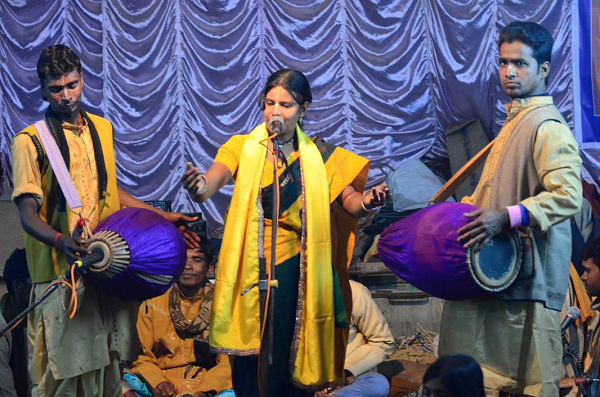
Female Kirtaniya
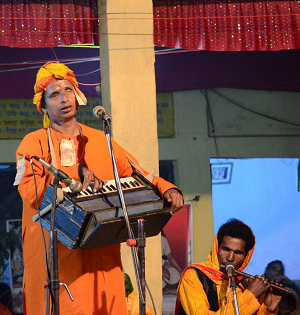
Blind Baul – he touched the heart of his audience and they profusely rewarded him with currency notes
After a good walk in the Mela, and driving away our sleepiness thus, we decided to return to Sudhir Kshyapa’s Akhra. As we walked towards the Akhra, we found police men snoring at their post. In my opinion there were not adequate police personnel in the Mela. As a result those who were on duty had a hectic time. Undoubtedly they tried their best, but with an ever pouring over-enthusiastic crowd, discipline was the last thing to be expected. This picture is not to criticize the police for negligence of duty, but to point out their pathetic condition.
Nowadays there are numerous Intellectuals or Elites who go to Jaydeb-Kenduli Mela. Of course there are those who really like Baul songs and Folk Culture, and hopefully, they are majority; however, there are those prominent “those” (called “Antel” in Bengali) who have other motives. Nandi-Bull’s vagabond Lord is always the Holy-Cow excuse for hemp smoking. We spotted these young men and women near the Akhra busy doing “Ganjika Sevan.”
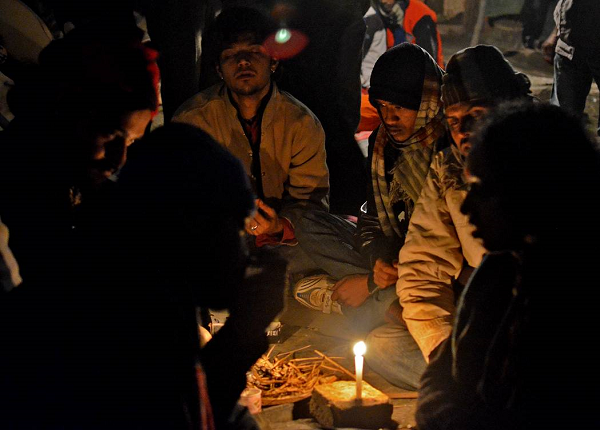
Shadowy characters smoking “Gaanjaa” in “Chhilim.”
Note the young boy – his eyes closed in real or affected ecstasy.
Also note the woman at the front – Gender Equality, so to say …
Reaching Sudhir Kshyapa’s Akhra and taking our seats (the previous occupants had been kind enough to go to sleep), we now saw some wonderful Bauls pouring out their Heart.
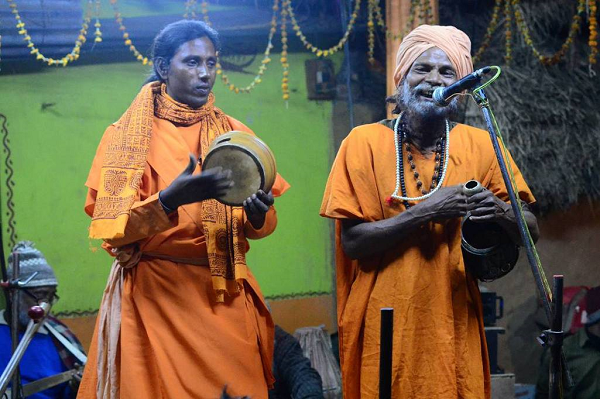
Sujan Kshyapa (right) and Lakshman Das Baul (left)
Another Baul captivated attention and left a marking impression because he played flute in the musical gaps of his song – a rarity. Perhaps he could feel Krishna in his heart while playing the flute. The Baul songs could really elevate the mind to a level that seemed to grant me glimpses of insight –
“While with an eye made quiet by the power
Of harmony, and the deep power of joy,
We see into the life of things.” (Tintern Abbey, Wordsworth)
The whole Mela now appeared to me in a new light, and I wondered whether that light would extinguish with the rising sun at dawn. I thought I could understand the significance of Krishna's words in Gita:
Yaa nishaa sarvabhuutaanaam tasyaam jaagarti samyamii /
yasyaam jaagrati bhuutaani saa nishaa pashyato muneh [Gita – 2.69]
Everything in the Mela, every people, every event – important or trivial – now seemed to me to be Metaphors for what the Baul stands for!
I remembered the Kadaambokhandi Smashan (crematorium) near our Akhra. I remembered the idol of goddess Kaali, the Goddess of Death, near the crematorium.
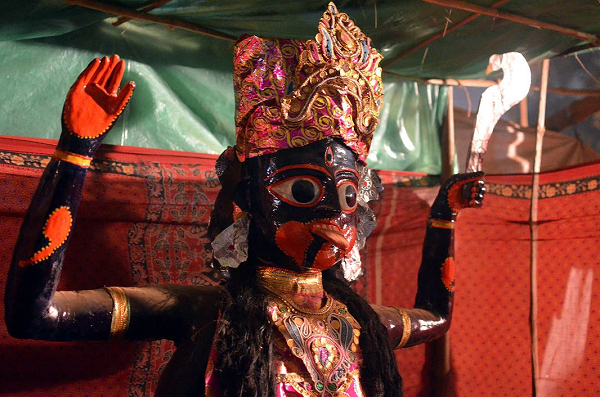
I remembered the burning of a corpse I saw at the crematorium sometimes back as I was sipping tea sitting on the metal frame-base of a pyre waiting for corpses to come. It did not strike me then that the next human on that pyre could be anyone - someone like me, or even me. I was not conscious of death at that time though a corpse burnt some feet away from me.
Now I recollected the scene – yes, I had taken a shot of the scene, but I had no need to view that on my camera monitor because I could remember every detail vividly.
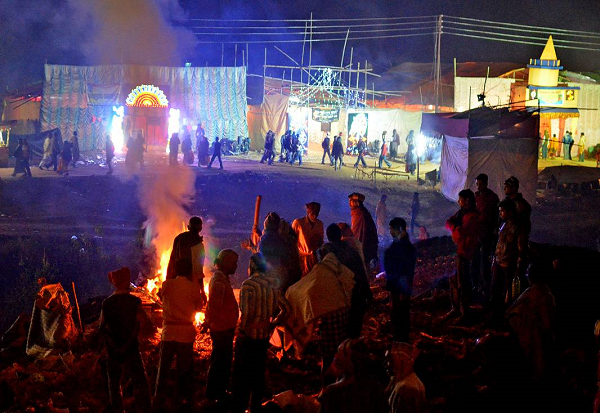
Corpse burning at Kadaambokhandi crematorium
– Baul Akhras at the background
To me this is the most symbolic picture that reflects Baul philosophy. A corpse burns at crematorium, but the Joy of Baul songs continue at the background – the air filled with the smoke of burning flesh, but also filled with the sound of Baul’s Natural and Spontaneous Ananda - the simultaneity of Life and Death – the conquest of Life over Death, accepting the inevitability of Death as a part of Life. If Ajaya River dries up, the Baul spirit remains ‘ajay’ – the unconquered.
Indeed, we need Bauls to teach us that, to remind us that constantly. After all, we all have a Baul in us.
Nothing is permanent in Life – and I remembered one Akhra where “no bird sing.” The Akhra wore a deserted look though it was full of people because no Baul had come there to sing at midnight, and all the people had gone to sleep. Amidst the chaos created by neighbouring Akhras, in this Akhra “absolute silence prevailed.”
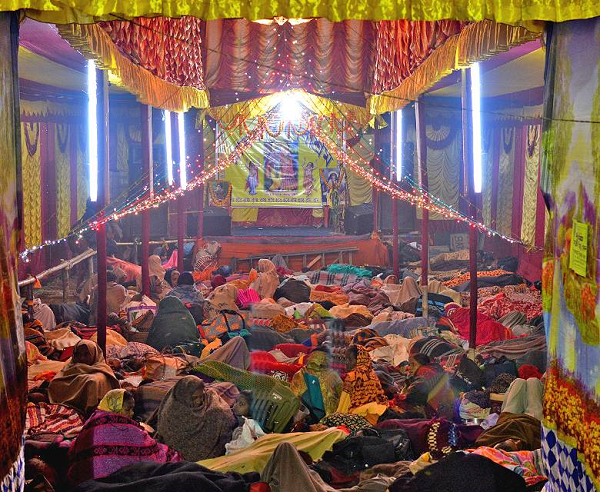
People asleep in an empty Akhra
To me, this Akhra stood as a metaphor for Sunyata (emptiness or void) – a symbol of the abandoned, neglected, marginal, and non-favoured. The Akhra even represented the socio-economic condition of many of those sleeping on its ground.
Goddess Kaalii is not merely the Goddess of Death, she is Primal Shakti, the Energy working behind every creation, and she is also Kaala, the Time.
If one corpse burns, then many people are alive too – Death is true but not the ultimate Reality. Kaalii, the Goddess of Death is also the Energy behind Ananda – and the Baul teaches that. Baul is hope.
I returned home with the face of that ever joyous Baul’s face deeply imprinted in my mind. His songs sent rapture through my veins and I began to dance … as Margot Cohen too danced in Joy oblivious of the curious spectators wondering at an “American Woman” dancing.
Information
1) How to go –
2) Where to stay –
See Also in Photo Essays:
The Bauls of Jaydeva Kenduli
20-Jan-2013
More by : Indrajit Bandyopadhyay

|
Thank you Sir For your Informative Blog, which help us. |

|
I have decided to visit joydeb kenduli mela in january 2016 based on your this guidance only . After vist I shall again post my experience. |

|
I am looking for an authentic Baul Singer, for Durgapuja function. Would you be able to share few contact details that you know of among the best ones? Thanks and regards, Sanatan Paul President Sparsh Cultural Society New Town, AA-III, Kolkata-700135 Mobile: 9007743027 |

|
Born and brought up in kolkata, many times i felt like going to Jaidev mela. But somehow it never happened. Today when i am far from West Bengal on this Makar Sankranti day i remembered Jaidev mela. This year also i could not go. So i visited the net and found your blog. i visited the mela through your writing. thank you so much. |

|
IT''S A NICE AND SO FAR COMPLETE WRITE-UP FOR A MAN LIKE ME. |

|
hello, thank you very good information.. we are planning to visit baul mela... is it possible we can speak to you before that... i am from mumbai |

|
emon report-er pore r kono katha hoy na. apnake aonek aonek aonek ....................... dhanyabad. |

|
VERY GOOD DESCRIPTION.I ALSO WANT TO GO.I AM VERY MUCH INTERESTED.I WILL BE VERY GLAD IF YOU HELP ME TO GO. |

|
amar kache ja chilo ajana , eman tathya jene amar mon bhore galo, dhanyabad, aonek aonek dhanyabad. |

|
thats what I call a true authentic report on the mela thank you we shall make good use of whatever you said and advice,I think whatever are the plans,we dont have any! we shall have to improvise and let ourselves be carried by the flow,I think we have an adress in shantiniketan to crash after exhaustion overtake us,just a bit scared of the cold since living in tamil nad for years we never see the thermometer going below 20 the dates not really understood we shall leave here from pondy and reach calcutta on the 12 then drop everything bulky in shantiniketan and proceed if you happen to read this tell us if its allright with the date, looking forward to get there jai guru |